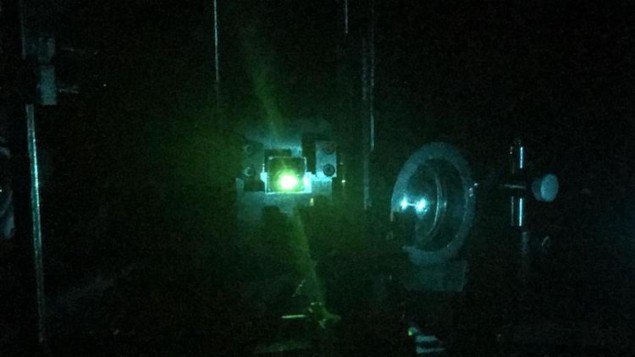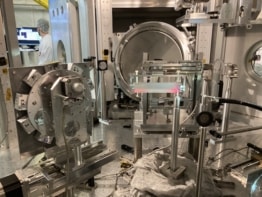
On paper, perovskites make great building blocks for lasers. In their quasi-two-dimensional form, these organic–inorganic materials exhibit tunable colour and excellent stability. The fact that they can fabricated from low-cost starting components in simple solution-based processes makes them attractive for manufacturers, too. There’s just one tiny flaw: perovskite-based lasers abruptly stop working after only a few minutes of constant operation at room temperature. Now, however, a team of researchers in China and Japan say they have overcome this so-called “lasing death” by suppressing long-lived energetic states known as triplet excitons.
Both 2D and quasi-2D perovskites are promising alternatives to silicon in optoelectronics devices. While 2D perovskites are made up of stacked sheets of alternating organic and inorganic layers, their quasi-2D variants contain small regions in which organic and inorganic materials alternate in all directions (as is the case in their 3D counterparts). The quasi-2D versions also contain two different types of organic materials.
In organic semiconductors such as those that make up quasi-2D perovskites, charge carriers – electrons and holes – come together to form an energetic state called an exciton. This entity may exist in a so-called singlet state (which has no net spin because the contributing electron spins point in opposite directions) or in a triplet state (in which the spins point in the same direction). In both cases, the energy in the exciton can then be released as light via a process known as radiative recombination. Triplets generally have a lower energy than singlets, however, and emit hardly any light.
Long triplet lifetimes
Recently, researchers led by Chuanjiang Qin of the Chinese Academy of Sciences and Chihaya Adachi at Kyushu University in Japan found evidence that triplet excitons have lifetimes of nearly a microsecond in these materials. These long lifetimes led them to focus on these excitons as a possible cause of lasing death.
As well as emitting very little or no light, triplet states also tend to interact with light-emitting singlets in a way that causes both to lose their energy without producing light, Qin explains. Eliminating any triplets in perovskites would therefore prevent interference with lasing.
In their latest work, the researchers studied FAPbBr3-based (where FA is formamidinium) quasi-2D perovskites with two different organic cations, phenylethylammonium bromide (PEABr) and 1-naphthylmethylamine bromide (NMABr). The PEABr-based perovskite contains an organic cation with high triplet energy, and the NMABr-based perovskite has an organic cation with low triplet energy.
Holding triplets in a low energy state
To eliminate triplets in these quasi-2D perovskites, the researchers incorporated an organic layer into the materials, which confines the triplets to a low-energy state. Since the excitons want to move to lower energies, the long-lived triplet excitons transfer from the active (that is, light-emitting) portion of the perovskites to the organic layer, they explain. This reduces light losses and allows for lasing under constant optical excitation (also known as optically pumped continuous-wave, or CW lasing) without interruption.

Managed triplets improve perovskite LEDs
Qin, Adachi and colleagues also discovered that they could make their material lase continuously simply by placing it in air. This is because oxygen can destroy triplets – a result that further suggests that light losses caused by triplets may indeed be the culprits in lasing death.
Unchanged lasing intensity
The researchers quantified their material’s performance by measuring the amplified spontaneous emission (ASE) intensity of the two films as they were optically powered. They found that the ASE, or lasing, remained virtually unchanged after an hour at room temperature in air with a relative humidity of 55%. The lasing spectrum also maintained its narrowness (full width at half maximum) without shifting. The team stress that these measurements were taken without the films being encapsulated in glass, and without a protective layer over their tops, as was the case in previous ASE stability measurements of 3D perovskites such as MAPbBr3.
According to the researchers, the excellent stability of their material comes from the protection provided by the larger cations on its surface. “We have demonstrated the key role of triplets in the lasing process of these types of perovskites and the importance of managing triplets to achieve continuous lasing,” Adachi states in a Kyushu University press release. “These new findings will pave the way for the future development of a new class of electrically operated lasers based on perovskites that are low cost and easily fabricated.”
The work is detailed in Nature.



